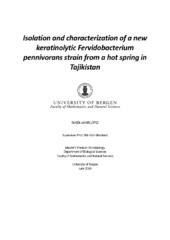Isolation and characterization of a new keratinolytic Fervidobacterium pennivorans strain from a hot spring in Tajikistan
Master thesis
Permanent lenke
https://hdl.handle.net/1956/18096Utgivelsesdato
2018-06-30Metadata
Vis full innførselSamlinger
Sammendrag
Thermophiles are organisms found among the Archaea and Eubacteria domains which are adapted to live at high temperature, the optimal growth temperature being between 50 °C and 79 °C. Phylum Thermotogae includes anaerobic and thermophilic members, and represents one of the deepest branching groups among the eubacterial line of descent, suggesting that the first eubacteria on Earth was thermophilic. Fervidobacteriaceae is a family within the Thermotogae phylum, some of which members can disintegrate chicken feathers, degrading the keratin, which is one of the most abundant proteins on Earth and often accumulates, causing a serious waste problem. Keratinases and keratinolytic microorganisms have biotechnological potential as they can convert this substrate into peptides and uncommon amino acids. This work includes the isolation, biochemical characterization and genomic analysis of a new strain of Fervidobacterium pennivorans, named strain T, isolated from a terrestrial hot-spring in Tajikistan. This strain is an anaerobic and thermophilic bacterium, with an optimal growth temperature of 65 °C. It can degrade feathers and tolerates up to 40 g/L NaCl concentration. It is a neutrophilic microbe, optimally growing at pH 6.5. Its draft genome consisted of 28 contigs with a total size near 2 Mega bases. The genomic analyses carried out include a Fervidobacteriaceae phylogenetic tree reconstruction and genomic comparisons of the studied strain with other Fervidobacterium pennivorans strains. These comparisons showed an 81 % overall sequence identity with the species type strain, isolated from the Azores, meaning that this new isolate, termed strain T, represents a new Fervidobacterium pennivorans strain. Peptidases of this bacterium were investigated using bioinformatic approaches. A putative keratinase was identified, and its 3D structure predicted by homology modelling. Furthermore, the peptidase catalytic triad was found by aligning its sequence with other homologue proteins. Finally, this enzyme was cloned and expressed in Escherichia coli and its activity investigated, showing promising results and new insight into this thermophilic group.
